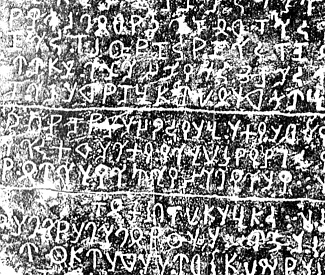

Zitierweise / cite as:
Burgess, James <1832 - 1916>: Indian Architecture (1910). -- (Quellenkunde zur indischen Geschichte bis 1858 / Alois Payer ; 5. Unbewegliche Hinterlasenschaften, 2.). -- Fassung vom 2008-03-21. -- http://www.payer.de/quellenkunde/quellen052.htm
Erstmals publiziert: in: Encyclopaedia Britannica. -- 11. ed. -- Vol 14. -- 1910. -- S. 428 - 434. -- Original online: http://www.archive.org/details/encyclopaediabri14chisrich. -- Zugriff am 2008-03-21
Erstmals hier publiziert: 2008-03-21
Überarbeitungen:
Anlass: Lehrveranstaltung FS 2008
©opyright: Public Domain
Dieser Text ist Teil der Abteilung Sanskrit von Tüpfli's Global Village Library
Falls Sie die diakritischen Zeichen nicht dargestellt bekommen, installieren Sie eine Schrift mit Diakritika wie z.B. Tahoma.
James Burgess (1832 - 1916) war Director des Archaeological Survey of India von 1885 bis 1889.
INDIAN ARCHITECTURE.
The development of architectural art in India is of the highest interest for the history of the subject; and whatever may be our estimate of its aesthetic qualities, we can hardly fail to realize that Indian builders attained with marked success the aims they had before them, though they employed arrangements and adopted forms and details very different from those of western builders in ancient and medieval times. These forms and adaptations, of course, require study properly to understand them, and to recognize the adjustment of the designs to their purposes. But besides the scientific advantages of such a study, it has been well remarked by Fergusson, to whose genius the history of Indian architecture is so specially due as its creator, that "it will undoubtedly be conceded by those who are familiar with the subject that, for certain qualities, the Indian buildings are unrivalled. They display an exuberance of fancy, a lavishness of labour, and an elaboration of detail to be found nowhere else." Besides, if anywhere the history of a country is imprinted in its architecture, it is in India that it throws the most continuous, distinct and varied light on that history.
In the early architecture of India, as in that of Burma, China and Japan till the present day, wood was solely or almost solely employed; and it was only about the 3rd century B.C. that stone became largely used as the material for important structures; if brick or stone were in use previously, it was only for foundations and engineering purposes. Even at the end of the 4th century B.C. Megasthenes states that Pataliputra, the capital of Chandragupta the Sandrokottos of Greek writers was "surrounded by a wooden wall pierced with loop-holes for the discharge of arrows." And if the capital were defended by such palisading, we may fairly infer that the architecture of the time was wholly wooden. On the Sānchi gateways, brick walk are indeed represented, but apparently only as fences or limits with serrated copings, but not in architectural structures. And at whatever date stone came to be introduced, the Hindus continued and repeated the forms they had employed in the earlier material, and preserved their own style, so that it bore witness to the general antecedent use of wood. Hence we are able to trace its conversion into lithic forms until finally its origin disappears in its absorption in later styles.
India possesses no historical work to afford us a landmark previous to the invasion of Alexander' the Great in the 4th century B.C., nor do we know of an architectural monument of earlier date. For later periods there are fortunately a few examples dated by inscriptions, and for others by applying the scientific principles developed by Thomas Rickman for the discrimination of other styles and the relative ages of architectural works, we are enabled to arrange the monuments of India approximately in chronological sequence or order of succession.
The invasion of Alexander and the westward spread of Buddhism brought India into contact with Persia, where the Achaemenian kings had hewn out mausolea in the rocks, and built palaces with stone basements, doorways and pillars, filling in the walls with bricks. These works would attract the attention of Indian visitors ambassadors, missionaries and merchants; and the report of such magnificent works would lead to their imitation.
About the middle of the 3rd century B.C. we find the great Aśoka, the grandson of Chandragupta, in communication with the contemporary kings of Syria, Egypt, Macedonia, Epirus and Cyrene; and to his reign belong the great stone pillars, with capitals of Persian type, that are engraved with his religious edicts. A convert to Buddhism, Aśoka is credited with the construction all over the country of vast numbers of stūpas monumental structures enshrining relics of Sakyamuni Buddha or other Buddhist saints; and with them were erected monasteries and chapels for the monks.
On the monumental pillars, known as lāts, set up by this emperor, besides the Persepolitan form of capital, we find the honeysuckle with the bead and reel and the cable ornaments that were employed in earlier Persian carvings; and though not continued later in India proper, these prevailed in use in Afghanistan for some centuries after the Christian era. This seems to indicate that these forms first came from Persia along with the ideas that led to the change of wooden architecture for that of stone.
The stūpas were structures that may be regarded as conventional architectural substitutes for funeral tumuli, and were constructed to enshrine relics of Buddha or of his more notable disciples, or even to mark the scene of notable events in the tradition of his life. How relic-worship originated and came to hold so large a place in the Buddhist cult we can hardly conjecture: the sentiment could not have arisen for the first time on the death of Gotama Buddha, when, we are told, eight stūpas were built over his corporeal relics, a ninth over the vessel with which they were divided, and a tenth over the charcoal of the funeral pile.
These stūpas, known as dāgabas in Ceylon, and chaityas in Nepal, are called topes in the ordinary patois of upper India. They consisted of a low circular drum supporting a hemispherical dome of less diameter and leaving a ramp or berme round it of a few feet in width. Round the drum was an open passage for circumambulation, and the whole was enclosed by a massive stone railing with lofty gates on four sides. These railings and gateways are their principal architectural features; the rails are constructed as closely as possible after wooden patterns, and examples are still found at Sānchi and Buddh-Gaya1; what remained of the Bharahat stūpa was transferred to the Calcutta Museum, and portions of the Amrāvatī rail are now in the British and Madras museums. The uprights and cross bars of the rails were in many cases covered with elaborate carvings of scenes of the most varied kinds, and are illustrative of manners and customs as well as of the art of sculpture.
1 The restoration of the shrine at Buddh-Gaya was begun in 1908 under the auspices of the Buddhist Shrine Restoration Society, of which the Tashi Lama was first president and the eldest son of the maharaja of Sikkim vice-president.
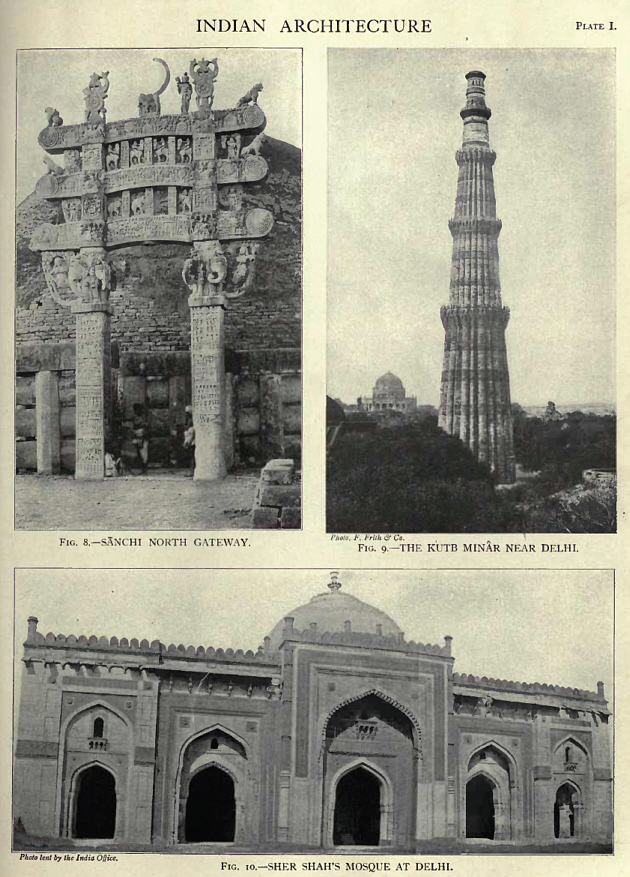
Abb.: Plate I
The great stūpa at Sānchi in Bhopal is now the most entire of the class, as it still retains the gateways -- styled torans -- which must have been a feature of all stūpas, though perhaps mostly [S. 429] in wood (see Plate I. fig. 8). The whole of the superstructure of the Sānchi examples is essentially wooden in character, and we are astonished that it should have stood "for twenty centuries nearly uninjured." These torans reappear to this day in Japan as tori-i and in China as p'ai-lus or p'ai-fangs. The whole of the surfaces, inside and out, are carved with elaborate sculptures of much interest. A cast of the eastern toran from Sānchi is to be seen in the museums at S. Kensington, Edinburgh, Dublin, Paris and Berlin. On the southern one, an inscription appears to indicate that it was erected about 150 B.C.
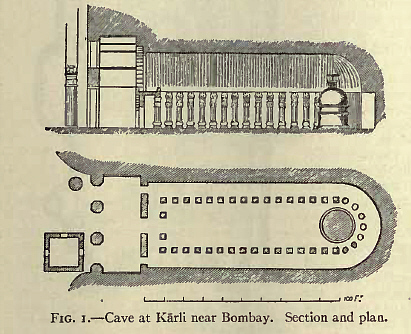
Fig. 1. Cave at Kārli near Bombay. Section and plan.
The earlier cave temples are of about the same age as the stūpas; some of those in Behar bear inscriptions of Aśoka and of his successor in the 2nd century B.C. And the earlier cave facades in western India indicate the identity of style and construction in the patterns from which both must have been copied. These Buddhist rock excavations are of two types: the chaitya or chapel caves, with vaulted roofs of considerable height, the earliest with wooden fronts and later with a screen wall left in the rock, but in both forms with a large horse-shoe shaped window over the entrance. The interior usually consisted of a nave, separated from the side aisles by pillars, and containing a chaitya or small stūpa at the inner and circular end. The facades of these chaitya chapels were covered with sculpture some of them very richly; and to protect them from the weather a screen was contrived and cut in the rock in front of the facade, with large windows in the upper half for the entrance of light.
This mode of lighting by a great arch over the entrance has attracted considerable attention, as being admirably adapted for its purpose. As Fergusson remarked, "nothing invented before or since is lighted so perfectly, and the disposition of the parts or interior for an assembly of the faithful ... is what the Christians nearly reached in after-times but never quite equalled."
The second type of rock excavations are known as vihāras or monasteries devoted to the residence of monks and ascetics. They usually consisted of a hall surrounded by a number of cells the earliest with stone beds in them. In the later vihāras there was a shrine in the centre of the back wall containing a large image of the Buddha. In the Orissa caves, near Cuttach, we have a series of excavations that do not conform to these arrangements: they are early, dating as far back as the 2nd century B.C., but they belong to the Jain sect, which dates from the same age as the Buddhist.
On the north-west frontiers of India, about the Swāt and Yūsufzai districts, anciently known as Gandhāra, are found a remarkable class of remains, much ruined, but that must have abounded in sculptures belonging to the Buddhist cult. It is among these we find the first representations of Buddha and of the characters belonging to the Buddhist pantheon. The influence of classical art manifested in these images leaves no doubt that they were modelled after western patterns, carried thither by Greeks or brought from the Levant by Buddhist emissaries. The scenes depicted, however, have frequently an architectural setting in which we find represented facades with pillars fashioned with distinctly Corinthian capitals. These sculptures we can now assign with confidence, from dated epigraphs, to dates from the last years of the century B.C. till the 4th century A.D. One inscription of A.D. 47 is of a king Gondophernes, who is mentioned in the legend of the apostle Thomas.
In the time of the great Gupta dynasty, from about A.D. 320 to 500, the architectural forms developed in variety and richness of decoration. To the columns were given higher square bases than before, and sometimes a sur-base; the capitals, which previously had a vase as the chief member, were developed by a foliaged ornament, springing from the mouth of the vase and falling down upon it from the four corners, and so lending strength to the neck whilst converting the round capital into a square support for the abacus. Often, too, a similar arrangement of foliage was applied to the early bases; and this form quite superseded the Persepolitan pillar, with its bell-shaped capital, which now disappeared from Indian art. The shafts were round or of sixteen or more sides; pilasters were ornamented on the shafts; and the spires of the temple were simple in outline and rose almost vertically at first and curving inwards towards the summit, which was always capped by a large circular fluted disk supporting a vase, whilst the surface of the tower was covered with a peculiar sort of horse-shoe diaper. This style prevailed all over Hindustan, and was continued with modifications varying with age and locality down almost to the Mahommedan conquest.
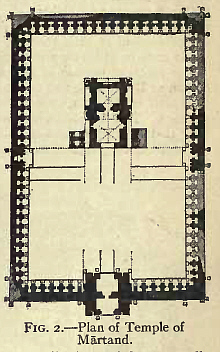
Fig. 2. Plan of Temple of Mārtand.
In Kashmir from the 8th century, if not earlier, till the Mahommedan conquest we find a style of architecture possessing a certain quasi-classical element which has little if any connexion with the art of the rest of India. The best-known example of this Kashmir style is the temple of Mārtand, about 3 m. east from Islāmābād or Anatnāg, the old capital. It stands in a court 220 ft. long by 142 ft. wide surrounded by the ruins of some eighty small cells, with a large entrance porch at the east end. The temple itself was 60 ft. long by 38 ft. wide, with two wings, and consisted of two apartments -- a naos and cella. The trefoiled or cusped arch on the doors of the temple and cells is a striking peculiarity of the style, and may have been derived from the section of the Buddhist chaitya. It is used decoratively, however, rather than constructively. The pillars and pilasters of the portico and temple bear a close resemblance to some of the later forms of the Roman Doric, and have usually sixteen shallow flutes on the shafts, with numerous members in the base and capital. A triangular pediment surmounts the doorways, and on gable-ends or projecting faces are representations of double sloping roofs, much in the style of modern Kashmir wooden roofs, of which also many of the temple-roofs in Nepal are exaggerated examples. The Mārtand temple was, in all probability, built in the 8th century, between A.D. 725 and 760, and was erected as a temple of the Sun, one of whose names is Mārtand. For, till the 12th century at least, Sun-worship was quite prevalent in the north and west of India. At a remote village called Buniār is a much better preserved [S. 430] specimen of the style: and at Avantipur, Vāngath, Payer and Pāndrethan are other interesting examples of the style. That at Pāndrethan about 3 m. from Srinagar is a well-preserved little temple, built between A.D. 906 and 921, and perhaps exhibits the most clearly the characteristics of the style.
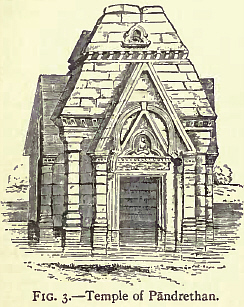
Fig. 3. Temple of Pāndrethan.
In the Himālayas the architecture is still largely wooden, raised on stone basements and is often picturesque. In the Nepal valley we meet with hemispherical chaityas or stūpas on low bases with lofty brick spires, and some of them of great antiquity, along with temples having three or four storeys divided by sloping roofs, and others in the modern Hindu style of northern India.
In South Kanara, especially at Mūdbidare (Mudbidri), there are also Jain temples and tombs with double and triple sloping roofs that resemble the native temples of Nepal, with which, however, they had no connexion. The whole style is closely in imitation of wooden originals, the forms of which have been derived from the local thatched dwellings of the district. The interiors of the Kanara temples are often very rich in carving, the massive pillars being carved like ivory or the precious metals. Associated with these and other temples are elegant, monolithic pillars placed on square bases, the shafts richly carved and the capitals wide-spreading, some of them supporting, on four very small colonnettes, a square roof elaborately modelled. These stambhas or pillars are the representatives of the early Buddhist lāts or columns raised at their temples, and bear emblems distinctive of the sects to which they respectively belong.
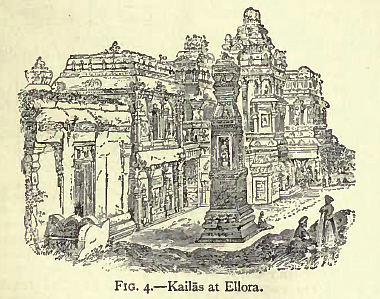
Fig. 4. Kailās at Ellora.
The southern portion of the peninsula is peopled by a race known as Dravidians, and to the style of architecture practised over most of this area we may conveniently apply the name of the race. This Dravidian architecture was essentially different from that of other regions of India and is of one type. One of the best-known groups of monuments in this style is that of the "Seven Pagodas" or the Mamallapuram raths, on the seashore, south from Madras. These raths are each hewn out of a block of granite, and are rather models of temples than such. They are the earliest forms of Dravidian architecture and belong to the 7th century. To the same age belongs the temple of Kailāsanāth at Conjeeveram, and to the following century some of the temples in the south of the Bombay Presidency, and the famous monolithic temple of the Kailās at Ellora near Aurangābād.
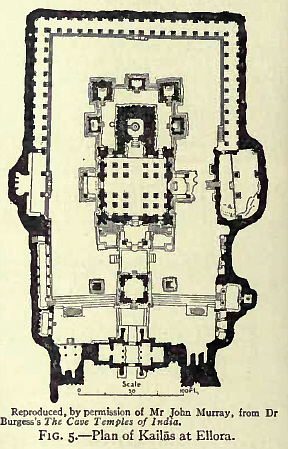
Fig. 5. Plan of Kailās at Ellora.
Buildings in the Dravidian style are very numerous in proportion to the extent of the area in which they are found. The temples generally consist of a square base, ornamented externally by thin tall pilasters, and containing the cell in which the image is kept. In front of this may be added a mantapam or hall, or even two such. Over the shrine rises the spire, of pyramidal form, but always divided into storeys and crowned by a small dome, either circular or polygonal in shape. The cornices are of double curvature, whilst in other Indian styles they are mostly straight with a downward slope. Another feature of these temples, especially those of later date, is the gopurams or great gateways, placed at the entrances to the surrounding courts, and often on all four sides. In general design they are like the spires over the shrines, but about twice as wide as deep, and very frequently far more imposing than the temples themselves.
The style is distinctly of wooden origin, and of this the very attenuated pilasters on the outer walls and the square pillars of small section are evidences. As the contemporary northern Styles are characterized by the prevalence of vertical lines, the Dravidian is marked by horizontal mouldings and shadows, and the towers and gopurams are storeyed. The more important temples are also surrounded by courts enclosing great corridors and pillared halls.
One of the best examples of this style is the great temple at Tanjore. It would appear to have been begun on a definite plan, and not as a series of extensions of some small temple which, by accident, had grown famous and acquired wealth by which successively to enlarge its courts, as that at Tiruvallur seems to have grown by a series of accretions. The body of the Tanjore temple is of two storeys and fully 80 ft. high, whilst the sikhara or pyramidal tower rises in eleven storeys to a total height of 190 ft. This dominates the gopurams over the entrances to the court in which it stands, and to an outer court, added in front of the first, but which docs not, as in other cases, surround it. The central shrine, so far as we know, was erected about A.D. 1025.
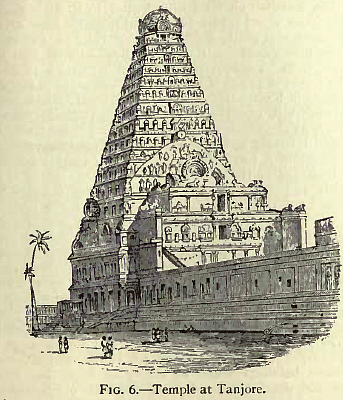
Fig. 6. Temple at Tanjor.
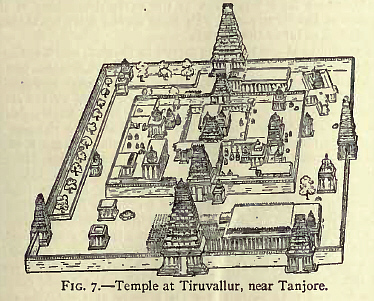
Fig. 7. Temple at Tiruvallur, near Tanjore.
The Srirangam temple in Trichinopoly, the largest in India, is architecturally the converse of this: it is one of the latest in date, the fifth court having been left unfinished in the middle of the 1 8th century. The shrine is quite insignificant and distinguished only by a gilt dome, whilst proceeding outwards, the gopurams to each court are each larger and more decorative than the preceding. The successive independent additions, however, proved incompatible with any considered design or arrangement of parts.
Most of the Deccan was ruled by the Chalukya dynasty from early in the 6th century, and the style prevailing over this area, [S. 431] from the Tungabhadrā and Krishnā rivers to the Tapti and Mahānadī, may be styled, from them, as Chalukyan.
The earliest temples in this style, however, are not very clearly marked off from the Dravidian and the more northern styles. Some of them have distinctly northern spires, others are closely allied to the southern style; and it was perhaps only gradually that the type acquired its distinctive characteristics. Till a late date we find temples with towers differing so little in form from Dravidian vimānas that, other details apart, they might readily be ascribed to that order.
Among Chalukyan temples a prevalent form is that of three shrines round one central hall. The support of the roofs of these halls is almost always after the Dravidian plan of four pillars, or multiples of four, in squares, so that larger domes were never attempted. Both in Dravidian and northern temples the projections on the walls are generally formed by increments of slight thickness added flatly to their faces, and, however thick, they are so placed as to leave the true corners of the shrines, &c., more or less recessed. In the Chalukyan temples the sides are often made prominent by increments placed over them, or the whole plan is star-shaped, the projecting angles having equal adjacent faces lying in a circle, as in the temple of Belūr in Mysore, built about A.D. 1120, and in others. The roofs are stepped and more or less pyramidal in form, with breaks corresponding to the minor angles made on the walls.
Some of the details of this style are very elaborate; in fact, many of the finer temples were completely overlaid with sculptural ornament. The pillars are markedly different from the earlier Dravidian forms: they are massive, richly carved, often circular and highly polished. Their capitals are usually spread out, with a number of circular mouldings immediately below; and under these is a square block, while the middle section of the shaft is richly carved with mouldings in the round. In many cases the capitals and circular mouldings have been actually turned in a sort of lathe. They are almost always in pairs of the same design, the whole effect being singularly varied and elegant.
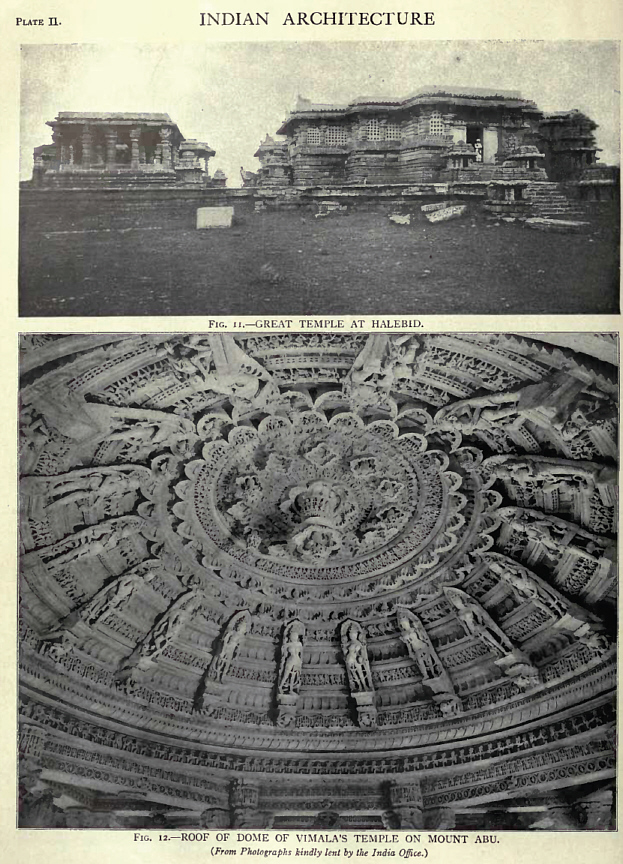
Plate II:
The great temple at Halebid (see Plate II. fig. 11), begun about A.D. 1250, was left unfinished at the Mahommedan conquest in 1310. It is a double temple, measuring 160 ft. by 122 ft., and is covered with an amazing amount of the richest sculpture. But the spires were never raised over the shrines. The Kedaresvara temple at Balagāmvī is perhaps one of the oldest of the style in Mysore, and there are other good examples at Kubattūr, Harnhalli, Arsikere, Harihar, Koravangala and elsewhere; but their plans vary greatly.
Coming now to Northern India, we find the Hindu architectural style more widely spread and more varied than in the south, but wanting somewhat in individuality. Examples of the same order, however, are to be found also far to the south in the Chalukyan area. The characteristic that first appeals to our notice is the curvilinear spires of the temples, and the absence of that exuberance of sculpture seen in the great Chalukyan temples of the South; whilst in many cases, as in the Jain temples, a greater central area has been obtained in the halls by arranging twelve columns so as to support a dome on an octagonal disposition of lintels. The shrines are square in plan and only slightly modified by additions to the walls of parallel projections; the walls were raised on a moulded plinth of some height, over which was a deep base, the two together rising, roughly, to about half the height of the walls. Over this is the panelled face devoted to figure sculptures in compartments, but the tall, thin pilasters of the southern style have disappeared. Above is the many-membered architrave and cornice supporting the roof and spire. The latter follow the vertical lines of the walls, presenting no trace of divisions into storeys or steps, but they vary in other details with the age.
In Rajputana and Western India a variety of this northern style has been known as the Jain order. Though used by the Hindus and Jains alike, it was employed in its most ornate form by the Jains in their famous temples on Mount Ābū and elsewhere. A striking feature of this style is the elaborately carved roofs over their corridors and the domes of their porches and halls (see Plate II. fig. 12). Nothing can exceed the delicacy and elaboration of details in these sculptured roofs and vaults. Combined with the diversified arrangement of the variously spaced and highly sculptured pillars supporting them, these convey an impression of symmetry and beauty that is highly pleasing.
Gujarāt must have been rich in splendid temples before the 12th century, but it was devastated so often by the Moslems that the more notable have all perished, though the once magnificent Sun Temple at Mudhera still witnesses, in its ruins, to the architectural style and grandeur of the period the early part of the 11th century when it was erected. A notable group of between thirty and forty temples in this style exists at Khajurāho in Bundelkhand. They belong to both the Hindu and the Jain cults, and mostly date from the 10th and 11th centuries. Many of them are covered, inside and out, with the richest sculpture, and may be regarded architecturally as "the most beautiful in form as well as the most elegant in detail" of the temples of Northern India. With these, the temples at Bhuvaneswar in Orissa exhibit this style at its best. The latter have the earlier form of spire, nearly perpendicular below, but curving inwards near the summit.
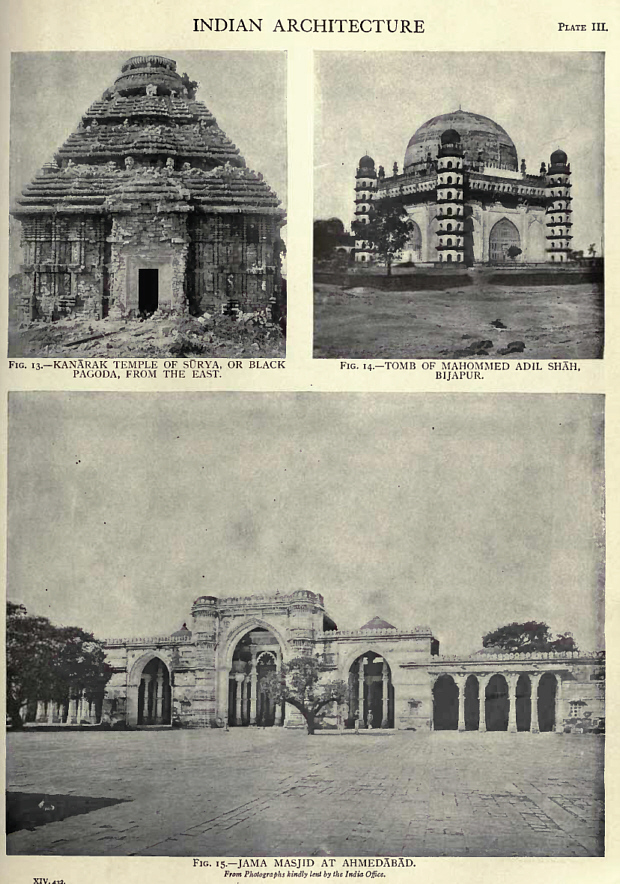
Plate III.
The temple of Kanārak, known as the "Black Pagoda" [S. 432] (see Plate III. fig. 13), which for its size is, externally at least, the most richly ornamented building in the world. It has lately been filled up with stones and sand, as the only method the Archaeological Survey could devise to prevent its threatened collapse.
In the later examples of the style the spire is still a square curvilinear pyramid, to the faces of which are added smaller copies of the same form, carrying up the offsets of the walls; and in some examples these are multiplied to an extraordinary extent.
The Mahommedan architecture, also known as Indian Saracenic, begins in India with the 13th century and varied much at different periods and under the various dynasties, imperial and local. The imperial rulers at Delhi, for the first three centuries, were Pathāns, and were succeeded in 1526 by Baber, who founded the Mogul dynasty. Under the earlier Pathān emperors the style of building was massive but profusely ornamented and of extreme beauty in its details. Among the examples of this style may be instanced the Qutb Minār at Delhi (see Plate I. fig. 9), one of the finest pillars in the world, built in the first quarter of the 13th century. It is still 240 ft. high and ornamented by projecting balconies and richly carved belts between; the three lower storeys are cut up by projecting vertical ribs that add to its beauty. Beside it the tomb of Altamsh is also profusely sculptured and of extreme beauty of detail, and other examples are seen in the eastern portion of the adjoining mosque, the tomb of Alā-ud-dīn Khilji, and the Alai Darwāza. After about 1320 the Pathān architecture is marked by a stern simplicity of design and a solemn gloom and nakedness, in marked contrast to the elaborate richness of ornamentation of the preceding period. The tomb of Ghiyās-ud-dīn Tughlak at New Delhi, with its sloping walls and massive solidity, is a typical example of this period, as is also the Kalān mosque at Delhi completed in 1386.
Early in the 15th century, however, a reaction had set in, and the later style was hardly less rich and much more appropriate for its purposes than the earlier in the end of the 12th and early 13th century. The facades of the mosques became more ornamental, were often encrusted with marble, and usually adorned with rich and beautiful sculpture. This was clearly a return to the elaborateness of the past, but with every detail fitted to its place and purpose and presenting one of the completest architectural styles of the world.
About the beginning of the 15th century several local dynasties arose, each of which developed a style more or less their own. Of the Shārki dynasty of Jaunpur only three great mosques in that city have come down to us, with several tombs. The cloisters surrounding the open courts of the mosques and the galleries within are closely allied to the Hindu style, being constructed with short square pillars having bracket capitals supporting lintels and roof of flat slabs. But the gateways and main features of the mosques are arched. The mosque itself consists of a central square hall covered by a lofty dome of the whole width of it, in front of which stands the great propylon or gate, of massive outline and rising to the full height of the central dome. This propylon had a large recessed arch between the two piers, in the lower portion of which was the entrance to the mosque, whilst the upper formed a pierced screen. On each side of the dome is a compartment divided into two storeys by a stone floor supported on pillars, and beyond this, on each side, is a larger apartment covered by a pointed ribbed vault. The ornamental work is bold and striking rather than delicate, and the mihrabs or qiblas are marked by severe simplicity, and form a link in the evolution of the later form under Mogul rule. These buildings afford a marked expression of strength combined with a degree of refinement that is rare in other styles. Other examples of this style are met with at Benares, Kanauj and places within the Jaunpur kingdom.
In 1401 Dilawar Khān assumed independence in Malwa, of which Māndu became the capital, and his son Hoshang adorned it with important buildings. They are of a modified form of the Pathān style of the 14th century. Among them the finest is the great Jama Masjid, which was finished by Mahmūd Shāh I. in 1454. It covers a nearly square area, 290 ft. from east to west by 275 ft. from north to south, exclusive of the porch on the east, which projects about 56 ft. Inside, the court is an almost exact square, surrounded by arches on each side, standing on plain square piers 10 ft. high, each of a single block of red sandstone; behind these are triple arcades on the north and south, a double one on the east, and on the west the mosque, having three great domes on its west side. This court, in its simple grandeur and expression of power, may be regarded as one of the very best specimens of this style to be found in India. The tombs and palaces of Māndu, mostly much ruined, it would occupy too much space to describe. But here, as elsewhere, the available materials have exercised a marked influence upon the architecture; the prevalence of a red sandstone is emphasized in the piers of the Jama Masjid, more than 300 of them being each of a single block of this material; and for more decorative purposes marble, both white and coloured, was freely used to revet the walls and piers. The style is strictly arcuate, without admixture of the general trabeate structural methods followed by the native Hindus; and while at Jaunpur and Ahmedābād, at the same period, we find the strong influence of native methods copied in the Mahommedan architecture, at Māndu the builders clung steadily to the pointed arch style, without any attempt, however, at groining.
The capital of the Bengal kingdom was at Gaur, which had been the metropolis of a native kingdom probably since the 9th century. As the country is practically without stone, the Hindu buildings would be chiefly of brick, but pillars, images and details were of hard potstone or hornblende; and these would afford materials for the Moslem conquerors. The construction of large buildings of brick required heavy piers for the arches and thicker walls than those constructed of stone. Then such piers and walls, when enriched by a facing of moulded or glazed tiles, would appear still heavier; and sometimes for tiles a casing of carved stone was substituted. Hence this style is a purely local one with short, heavy pillars faced with stone and supporting pointed brick arches and vaults. The use of brick further forced the builders to employ an arched style of their own and a mode of roofing in which a curvilinear form was given to the eaves descending at the corners of the structures. This form spread later up through Hindustan as far as the Punjab.
The capital at one time was moved to Pandua, north of Gaur, and there was built (1358-1368) the great Ādina mosque, 500 ft. in length by 285 in depth containing a large court surrounded by a thick wall of brick. The roof was supported by 266 stone pillars and covered by 378 domes, all of one form. Such a design has little architectural merit, but its size and the richness of its details make it an interesting study, and the same character belongs to most of the works of the Bengal Moslem rulers.
The Bahmanī dynasty, founded in 1347, had its capital at Gulbarga till 1428, when it was moved to Bīdar. During this period the city was adorned with important buildings of which the most notable now remaining is the great mosque, one of the most striking in India. It measures over all 216 ft. from east to west by 176 from north to south. It differs from all the great mosques in India in having the whole central area covered over as in the great mosque at Cordova what in others would be an open court being roofed by sixty-three small domes. The light is admitted through the side-walls, which are pierced by great arches on all sides except the west. The study is plain and substantial, with but little ornament. The tombs of the kings are massive square-domed buildings, with handsome stone tracery on their outer walls, and are elaborately finished inside. At Bīdar, mosques, palaces and tombs were also erected, but most of them have perished, the great mosque in the fort being the only one fairly entire. The ten tombs of the later Bahmanī kings, 5 m. from the city, are of like pattern with those of Gulbarga and of considerable [S. 433] splendour. They are not much ornamented, but are structurally good and impressive by their massive proportions.
Of the various forms which the Moslem architecture assumed, "that of Ahmedābād," Fergusson has justly remarked, "may probably be considered as the most elegant, as it certainly is the most characteristic of all. No other form is so essentially Indian, and no one tells its tale with the same unmistakable distinctness." Under the Mahommedan rule the Hindu architects employed introduced forms and ornaments into the works they constructed for their rulers, superior in elegance to any the latter knew or could have invented. Hence there arose a style combining all the beauty and finish of the previous native art with a certain magnificence of conception which is deficient in their own works. The elevations of the mosques have usually been studiously arranged with a view to express at once the structural arrangements, and to avoid monotony of outline by the varied elevation of each division. The central portion of the facade was raised by a storey over the roof of the wings, and to the front of this was attached the minarets, in the earliest mosques forming only small turrets over the facade, but soon after they became richly carved towers of considerable height. The upper storey formed a gallery under the central dome which was supported on pillars connected by open stone trellis work, admitting a subdued light, and providing perfect ventilation (see Plate III. fig. 15) . At first the facades were pierced by arched entrances, but at a later date a screen of columns formed an open front and the minarets were removed to the corners, no longer for the mu'azzin, but simply as architectural ornaments.
The tombs were pillared pavilions of varying dimensions, the central area over the grave covered by a dome standing on twelve pillars. These pillars connected by screens of stone trellis work carved in ever-varying patterns, and round this there might be a verandah with twenty pillars in the periphery, or a double aisle with thirty-two in the outer square. And as these were irregularly spaced in order to allow the inner-twelve to support the lintels of a regular octagon for the dome, the monotony of equal spacing was avoided. For further details and examples of this style, however, we must refer the reader to the published volumes of the archaeological survey of Western India relating to Ahmedābād and Gujarāt.
The Adil Shāhi dynasty of Bijapur (1492-1686) was of foreign extraction and held the Shiah form of Islam, prevalent in Persia, whilst they largely employed Persian officers. This probably influenced their architecture and led to that largeness of scale and grandeur which characterized the style, differing markedly from that of the buildings of Agra and Delhi, but scarcely, if at all, inferior in originality of design and boldness of execution. There is no trace of Hindu forms or details; the style was their own, and was worked out with striking boldness and marked success. The mode in which the thrusts are provided for in the giant dome (see Plate III. fig. 14) of Mahommed Adil Shāh's tomb (A.D. 1650), by the use of massive pendentives, hanging the weight inside, has drawn the admiration of European architects. And this dome, rising to about 175 ft. from the floor, roofs over an area 130 ft. square, or 2500 sq. ft. larger than the Pantheon at Rome, where stability is secured only by throwing a great mass of masonry on the haunches. The Jami masjid, begun by Alī Adil Shāh, 1567, but never quite completed, is one of the finest mosques in India. The central area of the mosque proper is covered by a large dome, supported in the same way as that on Mahommed Shāh's tomb. This dome, like all the earlier ones in India, perhaps wants in outside elevation; but in the splendid Ibrāhīm Rauza and mosque we find the domes elevated above mere segments. In this latter group, erected about 1626, the domes are more elevated, and we have every detail of the structure covered with the most delicate and exquisitely elaborate carving, the windows filled with tracery, and the cornices supported by wonderfully rich brackets. In the tomb too -- as if in defiance of constructional demands -- the room, 40 ft. sq., is covered by a perfectly level stone roof, supported only by a cove projecting on each side from the walls.
The Indian Saracenic style of the Mogul dynasty began under the emperor Baber, 1526; but one of the first and most characteristic examples that remain is the mosque of Sher Shāh (1541) near Delhi (see Plate I. fig. 10), and others exist at Rohtās. These earlier structures are interesting as the initial forms of the style, but are little known to Europeans. The emperor Akbar (1356-1605) built largely, and the style developed so vigorously during his reign that it would be difficult to enumerate the peculiarities of his numerous buildings. As in the Gujarāt and other styles, there is a combination of Hindu and Mahommedan features in his works which were never perfectly blended. Like their predecessors, the Pathāns, the Moguls were a tomb-building race, and those of the latter are even more splendid than those of the former, more artistic in design, and more elaborately decorated. The fine tomb of Akbar's father, Humāyūn, and the numerous structures at Fatehpur Sikri best illustrate the style of his works, and the great mosque there is scarcely matched in elegance and architectural effect; the south gateway is well known, and from its size and structure excels any similar entrance in India. And his tomb at Sikandra, near Agra, is a unique structure of the kind and of great merit.
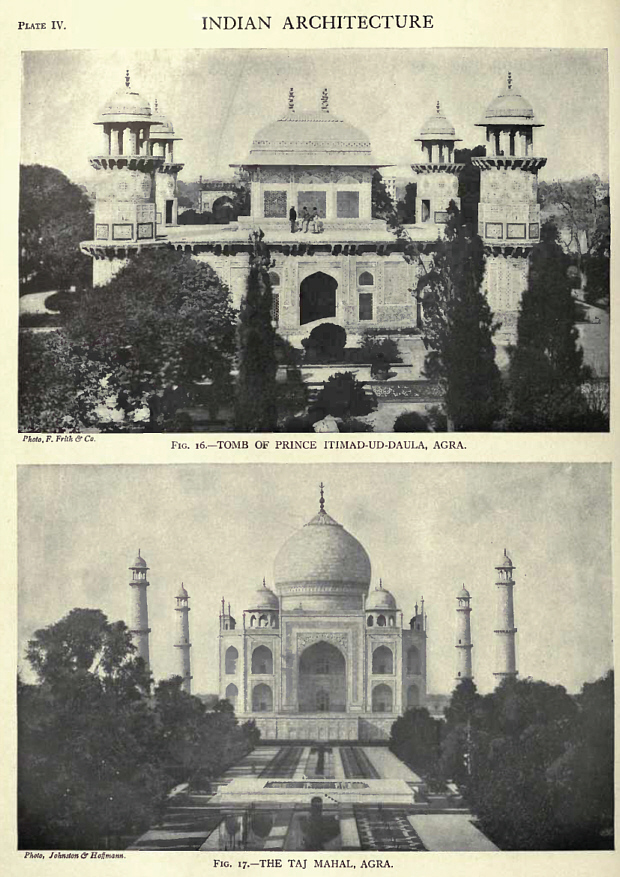
Plate IV.
Under Jahāngir the Hindu features vanished from the style; his great mosque at Lahore is in the Persian style, covered with enamelled tiles; his tomb near by (1630-1640) was made a quarry of by the Sikhs from which to build their temple at Amritsar. At Agra, the tomb of Itimād-ud-daula (see Plate IV. fig. 16), completed in 1628, built entirely of white marble and covered wholly by pielra dura mosaic, is one of the most splendid examples of that class of ornamentation anywhere to be found.
The force and originality of the style gave way under Shāh Jahān (1627-1658) to a delicate elegance and refinement of detail, illustrated in the magnificent palaces erected in his reign at Agra and Delhi, the latter once the most exquisitely beautiful in India. The most splendid of the Mogul tombs, and the most renowned building in India, is the far-famed mausoleum, the Taj Mahal at Agra (see Plate IV. fig. 17), the tomb of Mumtāz Mahal, the wife of Shāh Jahān. It is surrounded by a garden, as were almost all Moslem tombs. The extreme delicacy of the Taj Mahal, the richness of its material, and the complexity of its magnificent design have been dwelt on by writers of all countries. So also of the surpassingly pure and elegant Moti Masjid in the Agra fort, all of white marble: these are among the gems of the style. The Jama Masjid at Delhi is an imposing building, and its position and architecture have been carefully considered so as to produce a pleasing effect and feeling of spacious elegance and well-balanced proportion of parts. In his works Shāh Jahān presents himself as the most magnificent builder of Indian sovereigns.
In Aurangzeb's reign squared stone and marble gave way to brick or rubble with stucco ornament, and the decline of taste rapidly set in.
The buildings at Seringapatam and Lucknow are of still later date, and though in certain respects they are imposing, they are too often tawdry in detail.
BIBLIOGRAPHY.
J. Fergusson, History of Indian and Eastern Architecture (new ed., in press) ;
Fergusson and Burgess, Cave Temples of India, 8vo (London, 1880);
J. Burgess, Reports of the Archaeological Survey of Western India (9 vols. 4to, London, 1874-1905);
Rock-cut Temples of Elephanta (Bombay, 1871);
Buddhist Stupas of Amaravati, &c, (4to, 1887);
Ancient Monuments, Temples, Sculptures, &c., in India, 170 plates (fol. Griggs, London, 1897);
Gen. Sir A. Cunningham, Archaeological Survey of India Reports 1862-1885 (23 vols. 8vo, Calcutta, 1871-1886) ;
H. Cole, Preservation of Ancient Monuments in India, 100 plates (fol. Griggs, London, 1896);
G. le Bon, Les Monuments de l'Inde (fol. Paris, 1893);
E. W. Smith, Mughal Architecture of Fathpur-Sikri (4 vols. 410, Allahabad, 1894-1898);
Sir Lepel Griffin, Famous Monuments of Central India (fol. 1886);
A. Rea, Chalukyan Architecture of Southern India (4to, Madras, 1896) ;
A. Führer, Monumental Antiquities, &c., in the N.W. Provinces and Oudh (4to, Allahabad, 1891);
A. Foucher, L'Art gréco-bouddhique du Gandhára, 2 tomes (8vo, Paris, 1905-1908) ;
Grünwedel, Buddhist Art in India (Eng. trans., 8vo, 1901);
R. Phené Spiers, Architecture East and West (8vo, 1905);
H. C. Fanshawe, Delhi, Past and Present (8vo, 1902);
J. H. Ravenshaw, Gaur : its Ruins and Inscriptions (4to, 1878);
Sayyid Muhammad Latif, Lahore: its History, Architectural Remains, &c. (8vo, Lahore, 1892);
H. Cousens, Bijapur, the Old Capital of the Adil Shāhi Kings (8vo, Poona, 1908);
G. W. Forrest, Cities of India (8vo, 1903);
Dr W. H. and Mrs Workman, Through Town and Jungle, among the Temples and People of the Indian Plains (8vo, 1904).
(J- Bs.) [= James Burgess]
Zu: 5.3. Agriculture / by Edward Balfour (1885)